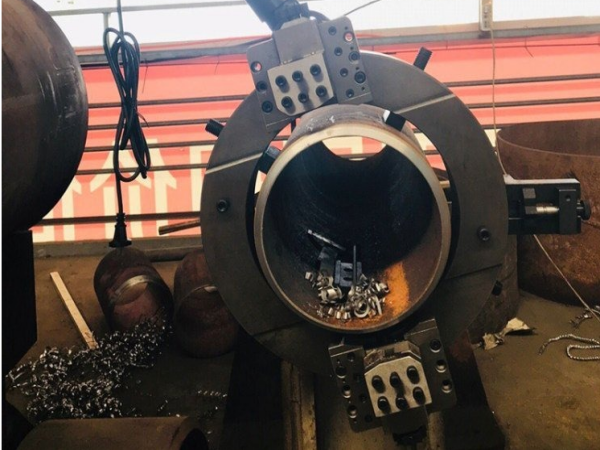What is pipe beveling?
Pipe beveling is an angle forming between the edge of the end of pipes or tubes. When the pipe end is formed with a certain degree of an angle, it is called a bevel end or beveled end. Pipe beveling is an essential step in the welding preparation process of pipe joining. The quality of the beveled pipe directly affects the quality of the welding, so proper pipe preparation ensures the best possible weld joint. Other than welding, beveling can also be used for deburring the cut pipe ends for aesthetic and safety reasons.
There are various ways to bevel pipes. Using a portable or stationary beveling machine, doing it by a hand grinder, or by a plasma or torch cutter.
The hand grinding method of pipe beveling is the cheapest and the most dangerous method compared to using pipe beveling machines. It is time-consuming and a skilled operator is required. In addition, it is nearly impossible to keep the bevel quality the same for each pipe operation while creating a lot of mess.

Using a torch or plasma cutter is another type of pipe end preparation machine. It provides faster results compared to a hand grinder, however; it also has some drawbacks. The flat land at the end of the pipe needs to be prepared by hand, which is not a safe process. Yet again, the command produced will be inconsistent.
Also, this pipe beveling method cannot be used on all materials, which would affect your flexibility in production.
A portable beveling machine comes in different configurations and is notably safer than the previous two methods. The biggest advantage of these portable machines is that they are portable so it's time-efficient since the user can take the machine to the pipe. They are convenient to use for maintenance work, or on a construction site. However, they are inadequate to meet high production requirements.
Stationary beveling machines provide the most options and flexibility for pipe beveling. Almost all kinds of pipe bevel shapes can be created with different combinations of tools. They are designed to meet high production requirements in a safe working environment. Also, stationary pipe beveling machines are easy to integrate with automated production lines, so the operator does not even have to be on the machine all the time. There are various benefits of stationary beveling machines such as; standard carbide cutting inserts are inexpensive to replace when needed, easy to set up and require low maintenance, ensure the lowest cost and fastest cycle time per bevel, provide a safe working environment without creating a mess, offers a broad range of machining options and can machine several pipe or tube materials, and does not require a skilled operator. Last but not least, stationary pipe beveling machines ensure constant pipe bevel quality that directly affects the quality of pipe welding.
What is correct, beveling, or bevelling?
Both beveling and bevelling are correct. 'Pipe bevelling' is the English UK spelling and 'pipe beveling' is the English US. Also, the wording pipe chamfering, pipe end working, pipe end preparation, and pipe prepping are other common terms for this application method.
Beveling vs. Chamfering: What is the difference?
Pipe chamfering is technically a type of pipe beveling. Chamfer vs. bevel: both terms refer to an edge forming between two faces of a pipe or tube. However, the main difference between pipe chamfering and pipe beveling is that a chamfer is an edge that connects two faces at a 45 degrees angle, whereas the bevel's slope can be any angle except 45 or 90 degrees.
Drawbacks of the Beveling Methods
|
Hand Grinding
|
Torch or Plasma Cutter
|
Portable Beveling Machine
|
Stationary Beveling Machine
|
|
Potential safety hazard
|
Fire hazard
|
Potential electrical cord hazard
|
Not suitable for on-site machining
|
|
Fire hazard
|
Requires touchups
|
Possible guarding issues
|
Relatively high investment cost
|
|
Creates a lot of mess
|
Creates a lot of mess
|
Needs a chip container
|
|
|
Time-consuming
|
Cannot operate on all materials
|
Expensive custom ground tooling
|
|
|
Inconsistent bevel quality
|
Requires Oxygen or dry compressed air
|
Time-consuming
|
|
|
Expensive grinding wheels
|
Cannot process J-bevels or special shapes
|
|
|
|
Cannot process J-bevels or special shapes
|
|
|
|
Read more: What is pipe beveling? or Why Pipe Beveling is Important for Welding













 Eastern Steel Manufacturing Co.,Ltd not only improve product production and sales services, but also provide additional value-added services. As long as you need, we can complete your specific needs together.
Eastern Steel Manufacturing Co.,Ltd not only improve product production and sales services, but also provide additional value-added services. As long as you need, we can complete your specific needs together.










